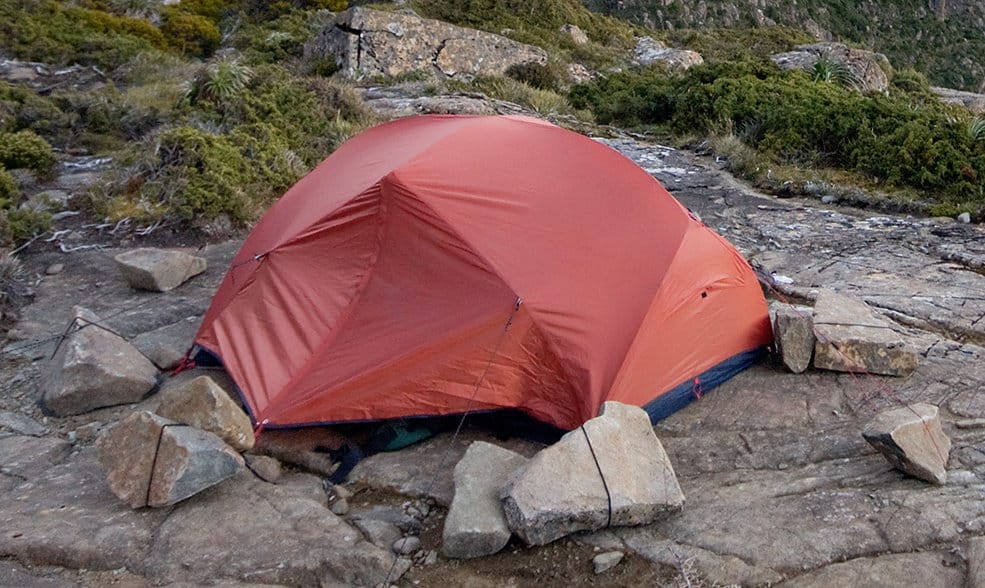After a lot of testing over Winter and Spring 2020, we determined that the ALPS Mountaineering Lynx 1-Person Tentis the best one man tent. The Mountaineering Lynx 1-Person Tentis roomy with superior ventilation for comfortable camping on warm summer nights. Setup is easy too with this durable tent. It is well constructed and kept us dry in the rain. Besides all that, it looks slick too.
Contents
Our Favorite 1 Person Tent
- Free standing, two pole design w/7000 Series aluminum poles; Easy assembly with pole clips; 75D 185T polyester fly resists UV damage and stays taut
- Factory sealed fly and floor seams for best weather protection; 75D 185T Poly taffeta floor w/2000mm coating; Extra-large #8 zippers
- Vestibule for gear storage and extra weather protection; Weatherproof fly buckles on for maximum adjustability and protection
This tent had a lot of extra features that made it stand out from the competition. We loved the extra-large zippers which were easy to use without getting stuck. It includes a vestibule which we always appreciate in any tent. With aluminum poles, it keeps the weight under four pounds for easy transport.
- The ALPS Mountaineering Lynx 1-Person Tent has a spacious floor plan for a one man tent at 90” x 32” x 36”.
- Mesh walls for outstanding ventilation
- Factory sealed seams and rainfly
Runner-Up
- STAY DRY: Waterproof rainfly with a 360-degree ventilation system for optimal air flow that allows a cool, comfortable night’s sleep; 1 to 4 person camping tents available
- ROOM WITH A VIEW: Get away from the city lights and enjoy a full view of the Milky Way; Full dome mesh top allows for an amazing stargazing experience
- EASY TO SET UP: Lightweight tent packs down tight for backpacking, hiking and camping; Micro mesh inner tent with perfect fitting, waterproof rainfly
The deciding factor between theALPS Mountaineering Lynx 1-Person Tentand theTETON Sports Mountain Ultra Tentwas the extra leg room. The total pack weight was comparable. We were impressed that it included a footprint to cover the ground and help with water resistance. The tent is composed primarily of mesh panels, making the rainfly essential for privacy.
TETON Sports Mountain Ultra Tent
- Extra high bathtub floor for better water resistance
- Includes the rainfly and footprint
- Clip-on rainfly for quick installation
Honorable Mentions
Several other tents caught our attention for the added features that they included. Both are alternatives offer something extra that we don’t see as often in other products. That may make them more of a niche product. These extras offer a different camping experience that makes each one worth a look.
- POPS UP IN AN INSTANT: Camping made easy; Buying the tent will take you longer than setting it up will; Roll it out, lock your poles, pull the drawstring -- done!
- STAY DRY AND KEEP COOL: Sturdy micro mesh tent includes a standard waterproof rainfly; Look for the Elite Rainfly that fully extends to the ground while using the cot — sold separately
- ROOM WITH A VIEW: Get away from the city lights and enjoy a full view of the Milky Way; Full mesh top allows for a perfect stargazing experience
- Quick instant setup with attached poles
- Use as a freestanding tent or with a cot with six attachment points
- Built-in vestibule for added storage
- Inner tent dimensions are 94 inches long, 35 inches wide, and 28 inches tall; built to accommodate 1 person and their gear, features tape sealed seams
- Lightweight and compact pack size is 19 inches long by 5.5 inches wide; trail weight is 2.64 pounds, pack weight is 3.34 pounds
- Equipped with DAC Featherlite NSL anodized aluminum poles with press fit connectors; features No-See-Um mesh mosquito net for warmer climates
- Compact, low-profile shape with extra long 92” length
- Lightweight at under four pounds total pack weight
- Rainfly with 5000mm waterproof polyurethane coating
One Person Tent Buying Guide
Comfort is the main consideration when buying a one-person tent. The best tents will provide adequate space with plenty of airflow to prevent condensation build-up. There’s not much worse than a damp tent especially if you’re stuck inside because of the weather. And you’ll need some place to store your gear too. Size is an essential factor.
Things to Consider When Buying a One Man Tent
- Type of Tent
- Dimensions
- Design
Introduction
If you’ve starting looking for the best one man tent, you’ll know that there are numerous products from which to choose. That can make it more difficult to narrow down your choices. This guide will help you determine the best tent for your needs. It begins with the kind of camping that you do so that you’ll know which features are most important.
Type of Tent
There isn’t just one type of one person tent which is why you need to focus on your camping you do. Each type has specific features to match the typical outing. The first consideration is whether you backpack or car camp. For the former, weight is going to be a consideration of utmost importance. Ounces matter when you’re carrying a pack with a tent on your back.
Backpacking Tents
Backpacking tents come in ultralight and standard. The difference between the two is weight. Ultralight tents weigh less than two pounds. However, it doesn’t mean that they’re any less sturdy or roomy than other types. They often include a larger portion of mesh panels and fewer poles to cut down on the weight.
You’ll see weights listed for tents as the trail pack weight and the total pack weight. The former is what you’re carrying with just the basics. The latter is with the tent and all the accessories such as stakes included. The total figure is probably the most important so that you can have all you’ll need to match the changing weather conditions.
Car Camping Tents
Weight, of course, isn’t as much of an issue if you’re parking at a base camp and setting up a tent. You should still choose a high-quality product that will keep you dry and comfortable. Easy setup is an essential consideration no matter what kind of camping you do.
Dimensions
Unfortunately, there isn’t one set standard across the industry for occupancy sizes. Rather, you’ll see a lot of variation between manufacturers. That’s why it’s important to know all the dimensions of a tent and not just the square footage.
You’ll see them listed as length, width, and height. If you’re taller, the length is going to make a big difference in your ability to stretch out. If you’re a restless sleeper, you’ll want a roomier tent with a larger width. You’ll most likely see tents under four feet in height for one person tents. Just make sure it’s high enough for you to sit comfortably.
Design
The extra features are often the deciding point when it comes to choosing the best 1 person tent. These small details often add a lot of value to your purchase and can make the difference between a good and a high-quality model.
Tent Shape
The shape of the tent is another essential factor when it comes to the usable space within a tent. One of the most popular types is the dome tent. This one offers excellent stability in windy conditions. They are freestanding so that you can move it if necessary.
You’ll also find tunnel or hoop-shaped tents. Unlike dome tents, they are not freestanding. That means that setup is more involved with stakes. On the plus side, they are often lighter if weight is an important consideration.
Walls
Tents are either single or double walled. Single-wall tents are composed of one layer of waterproof/breathable material. They are often lighter which makes them a smart choice for backpacking. However, you should make sure there is enough ventilation to avoid condensation.
Double-wall tents include the main living space and a rainfly for protection from the elements. They typically have one more mesh panels for excellent airflow. While the rainfly means extra time to set up, it also adds to the versatility of the tent.
Vestibules and Storage
For a one person tent, a vestibule is essential when space is at a premium. These sheltered features provide extra storage area to keep the tent from feeling cramped. They are handy for storing wet or dirty gear to keep the inside clean and dry. Think of them as your tent’s mudroom.
Tents usually include extra storage areas to help you stay organized. Look for features such as wall pockets or a gear loft to keep essential in handy reach. Another welcome add-on is a ceiling loop so that you can hang a lantern inside. When you’re dealing with a small space, these extras make a huge difference.
Ventilation
Ventilation can either make or break a pleasurable camping trip. Mesh panels ensure that the air keeps moving when you’re tent-bound or sleeping. And no-see-um netting is vital no matter what size tent you use. There should be some space between the tent and the rainfly so that you can stay comfortable when the weather takes a bad turn.
Tent Poles
You’ll find tent poles made of a variety of materials including carbon fiber, fiberglass, and aluminum. The latter has the advantage of being both lightweight and durable. And remember that fewer the poles means a quicker the setup. Also, pay attention to how they attach to the tent.
Clip-on attachments provide the easiest setup and teardown. There are also short or long sleeves through which you’ll pass the tent poles. A combination of clips and short sleeves is ideal. Some tents come with pre-attached poles so that all you need to do is unfold and extend the tent.
Freestanding versus Non-Freestanding
The difference between the two types lies with setup time and portability. You can move a freestanding tent to match the wind direction for maximum ventilation. Moving a non-freestanding tent is a longer process. No matter what types, you should still stake it down to keep it in place.
General Advice
The best tip we can give you when buying a one man tent is to set it up at home before you go camping. You should feel comfortable setting it up and packing it up for the return trip. It’s also an excellent time to try it out to make sure it’s comfortable and has plenty of room for you and your gear. You’ll appreciate your efforts when it’s time to set up camp after a long day on the road.
Our Pick for the 1 Person Tent





